 The
Centrality of the Longsword
The
Centrality of the Longsword
in the Study of Renaissance Martial Arts
“there is only one Art of the sword” it is “the basis and a core of all the arts of fighting.”
- Master Johannes Liechtenauer, 1389
By John Clements
Why the longsword?
– This is a question I have often asked myself and one which many
students of this craft has also asked of me over the years. Personally, I have
always favored the double-hand sword. The symmetry of a long, straight,
two-edged blade with cross-guard has a formidable elegance all its own. Though
I grew up playing "sword and shield" then got into modern "foyning" fence and,
as most adolescents do, for a time became fascinated with the katana, the later
discovery that there was a systematic historical method to using the European
longsword became the real revelation.
Even as I readily adore training with all manner of Medieval and
Renaissance weaponry, and particularly the rapier as well as sword &
dagger, for me the longsword has held a special place. I have long felt this was the case
historically as well. Recently, the centrality
of the longsword to the Renaissance arts of fighting
has become even more apparent.
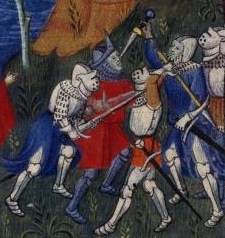 No other historical hand-weapon was arguably as resourceful
as the longsword. It possesses a versatility suited to battlefield,
single-combat, or common-defense against the widest array of arms and armor.
The longsword could be manipulated as spear and war-hammer as well as
short-sword. Whether as warsword, bastard-sword, spadone,
estoc, Schlachterschwerter, or greatsword, I have come to see the double-handed straight sword as containing
within its practice nearly everything that is found in other weapons. Its core
basis is identical to that for using so many others, be it dagger, spear,
polaxe, or short side-sword. Extensive study of this weapon has convinced me
that practice in it provides the greatest foundation for understanding the diverse
teachings of Renaissance martial arts, from unarmed grappling to sword &
buckler and even the rapier.
No other historical hand-weapon was arguably as resourceful
as the longsword. It possesses a versatility suited to battlefield,
single-combat, or common-defense against the widest array of arms and armor.
The longsword could be manipulated as spear and war-hammer as well as
short-sword. Whether as warsword, bastard-sword, spadone,
estoc, Schlachterschwerter, or greatsword, I have come to see the double-handed straight sword as containing
within its practice nearly everything that is found in other weapons. Its core
basis is identical to that for using so many others, be it dagger, spear,
polaxe, or short side-sword. Extensive study of this weapon has convinced me
that practice in it provides the greatest foundation for understanding the diverse
teachings of Renaissance martial arts, from unarmed grappling to sword &
buckler and even the rapier.
Background & Context
There is no question that the largest pool of surviving
instructional literature on pre-Baroque European fencing concerns the use of
different forms of late-Medieval double-handed sword. The longsword dominated
the literature on unarmored and armored foot combat for more than 200 years.
From the mid-1300s (and into the early-1600s) the weapon was the focus of
considerable exploration until the ascendance of the rapier in the face of new
military technology and changing civilian self-defense conditions during the
mid-1500s.
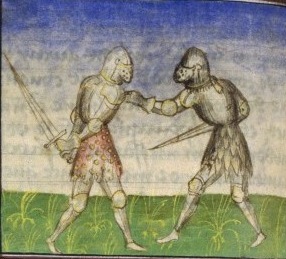 Instructional material on the longsword makes up an
extensive component of Renaissance martial arts teachings. We need only consider the foundational
writings on Johannes Liechtenauer's method beginning in 1389, the important
work of Fiore Dei Liberi from 1410, through the voluminous contributions of
many 15th century Fechtmiesters that followed, up to Fillipo Vadi in
the 1480s, and Pietro Monte by 1500, to a host of anonymous works and rewritten
teachings into the mid-16th century. One of the final expressions of
its teachings culminated in the published treatise of Joachim Meyer in 1570.
Instructional material on the longsword makes up an
extensive component of Renaissance martial arts teachings. We need only consider the foundational
writings on Johannes Liechtenauer's method beginning in 1389, the important
work of Fiore Dei Liberi from 1410, through the voluminous contributions of
many 15th century Fechtmiesters that followed, up to Fillipo Vadi in
the 1480s, and Pietro Monte by 1500, to a host of anonymous works and rewritten
teachings into the mid-16th century. One of the final expressions of
its teachings culminated in the published treatise of Joachim Meyer in 1570.
When we think of swordplay in the Renaissance the slender
thrusting sword, or rapier, almost immediately comes to mind as the
representative weapon of the Age. It is the basic techniques of the single-hand
rapier that survives today in its post-Baroque descendants of modern sport
fencing. Yet, when considered separately from its earlier cut-and-thrust cousin
(the military side-sword of the early 16th century) the true rapier
had a narrower and more specialized self-defense role. Even during its highest
period of popularity in the early 17th century, it remained one of
many swords types contemporary with more traditional military cutting blades and
common polearms. The martial conditions of which these slender thursting swords were employed and
the challenges they were called upon to face had also both changed considerably over
that which earlier had once necessitated the development of the earlier longsword. When we deliberate on the true rapier,
its origin as a civilian weapon of street-fighting and its later incarnation as
the dueling weapon par excellence among the aristocracy, its place within Reniassance combatives was not a
central one considering the totality of fighting arts in the era.
 Indeed, for the fighting method of this slender thrusting
sword, the true rapier is found in less
than a dozen instructional texts from the middle of the 1500s to the middle of
the 1600s (e.g., Lovino, Ghisliero, Heredia, Narvaez, Saviolo, Fabris, Swetnam,
Hale, Giganti, Capo Ferro, Alfieri, etc.)
Even then, the authors of several of these important works often still
included material on older short swords or back-swords as well as polearms or
even the two-handed greatsword.
Indeed, for the fighting method of this slender thrusting
sword, the true rapier is found in less
than a dozen instructional texts from the middle of the 1500s to the middle of
the 1600s (e.g., Lovino, Ghisliero, Heredia, Narvaez, Saviolo, Fabris, Swetnam,
Hale, Giganti, Capo Ferro, Alfieri, etc.)
Even then, the authors of several of these important works often still
included material on older short swords or back-swords as well as polearms or
even the two-handed greatsword.
More so than any other single weapon the fearsome longsword,
with its utility, versatility, and inherent use of half-gripping the blade and
close-in body-to-body action, embodies the knightly Art of Combat. By contrast, the later rapier, though it developed
from earlier tapering single-hand swords, was specialized more to unarmored private
duelling. It was really only when military conditions began to change and
armored faded in the face of firearms, that the longsword became impractical
for civilian security and "cavalier" affairs of honor, as well as unnecessary
for general war.
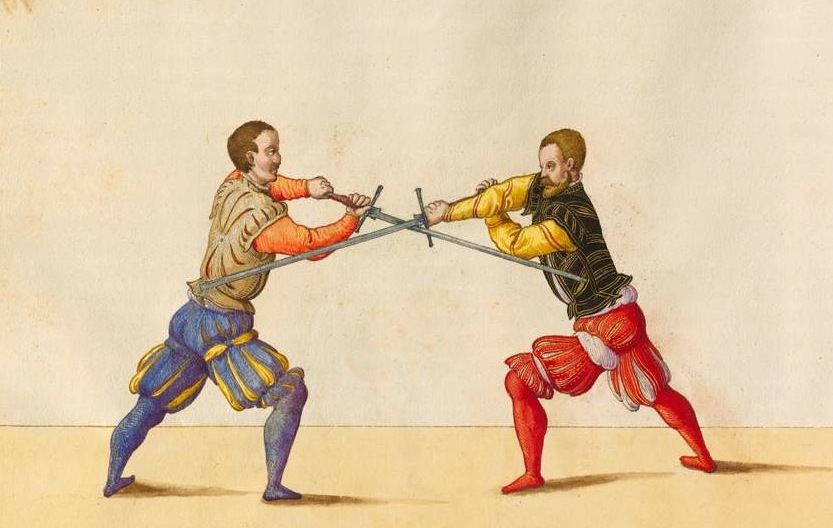 What Role in the Art of Defence?
What Role in the Art of Defence?
What was it then about the use of longer double-handed
blades that earlier attracted so much focus from fighting men and fencing
masters? What was it about this
weapon that they considered it with such apparent regard? What was it that compelled them to give
it so much attention over (presumably) more common single-hand swords which
were their contemporaries as well as predated them? Why was so much instructional material devoted to the long
double-handed sword rather than to single-handed versions or pole-arms? The
answer to the question of the longsword primacy is its popularity was no matter
of some mere knightly symbolism but a direct factor of its pragmatic utility.
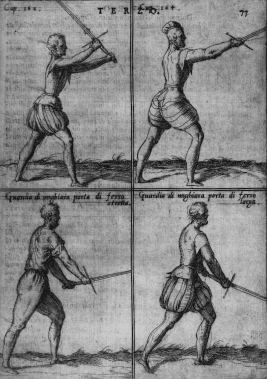 Of the longsword, the grandmaster Johannes Liechtenauer in
the late 14th
century taught, "there is only one Art of the sword"
and it is the "basis and a core of all the arts of fighting." In
his
later fighting treatise of 1570, the master Joachim Meyer wrote how the
weapon, "is celebrated among other weapons for artfulness and
manliness, and because of
it I have what's needed for good understanding from which to make
progress, and
thus quickly see with clarity how with wise handling all this can be
applied in
other arts and disciplines." Of his tapered double-edged spada a doy mane
or “two-hand sword,” the
master Fiore dei Liberi in 1410 declared it “mortal against any weapon”
adding that it: "fights near or far, closes in for disarms and
wrestling, can break and bind, cover and injure, and is a royal weapon,
the maintainer of justice used to increase goodness and destroy
malice."
[Getty 25r].
Of the longsword, the grandmaster Johannes Liechtenauer in
the late 14th
century taught, "there is only one Art of the sword"
and it is the "basis and a core of all the arts of fighting." In
his
later fighting treatise of 1570, the master Joachim Meyer wrote how the
weapon, "is celebrated among other weapons for artfulness and
manliness, and because of
it I have what's needed for good understanding from which to make
progress, and
thus quickly see with clarity how with wise handling all this can be
applied in
other arts and disciplines." Of his tapered double-edged spada a doy mane
or “two-hand sword,” the
master Fiore dei Liberi in 1410 declared it “mortal against any weapon”
adding that it: "fights near or far, closes in for disarms and
wrestling, can break and bind, cover and injure, and is a royal weapon,
the maintainer of justice used to increase goodness and destroy
malice."
[Getty 25r].
The weapon may have been less numerous in warfare than
simple (and cheaper) polearms wielded by common infantry, but there is no
mistaking that by the 1300s all social classes employed swords, including the
double-handed version.
The ease by
which the longsword transitions from one-handed to two-hand techniques, between
cuts and thrusts and slices, and shifts between half-swording and
full-gripping, gives it an unprecedented versatility. Simply put, there are
blows and cutting strikes performed in a certain way with a two-handed weapon
that are not performed with a single-hand one.
There are things you do with a cutting and
thrusting blade---whether armored or unarmored on foot or
mounted---that you do not do with a trusting-only sword in one hand
(nor even with a
shafted pole-arm held in two). The left hand is also free to do things
that
cannot be done with a shield or another weapon held in the second hand,
while
half-swording provides flexible options that are not as available to
shorter
weapons. Whether for war, duel, or common self-protection the weapon
proved
itself in diverse conditions. It is no wonder it served as such a sound
basis
for learning how to fight.
 The nature of armed close-combat is such that fighting with
the longsword cannot be properly practiced without learning the basics of
timing, range, blade pressure and body leverage. These key elements cannot be
skipped in order to move onto "other aspects" of the Art. They are its core
essence and until a student acquires these fundamentals, the nature of the real
Art will continue to elude them. Wielding this weapon properly is about so much
more than holding stances and making assorted strikes or parries. Beyond cutting, slicing,
or thrusting, a good deal of this skill involved closing-in to bind and seize
the opponent—knocking, disarming, or throwing them. When training with a
longsword is approached correctly these elements are encountered at once and
acquired very quickly by the student. While at the same time, it also becomes
clear that the weapon is not about simplistic parrying and riposting while just
warding and stepping in and out of timing and range.
The nature of armed close-combat is such that fighting with
the longsword cannot be properly practiced without learning the basics of
timing, range, blade pressure and body leverage. These key elements cannot be
skipped in order to move onto "other aspects" of the Art. They are its core
essence and until a student acquires these fundamentals, the nature of the real
Art will continue to elude them. Wielding this weapon properly is about so much
more than holding stances and making assorted strikes or parries. Beyond cutting, slicing,
or thrusting, a good deal of this skill involved closing-in to bind and seize
the opponent—knocking, disarming, or throwing them. When training with a
longsword is approached correctly these elements are encountered at once and
acquired very quickly by the student. While at the same time, it also becomes
clear that the weapon is not about simplistic parrying and riposting while just
warding and stepping in and out of timing and range.
Beyond Both Cutting or Thrusting
There is a self-evident urgency to training with weapons.
They contain an immediacy of threat over that found in grappling or wrestling.
Weapons have been called the great equalizers, for it is their lethality that
gives them precedent over unarmed combat. In the historical training of
warriors there is a simple truth: arms inherently require unarmed skills, but
unarmed skills do not inherently require armed training. No historical warrior could be
effective in battle or duel if he had just studied in unarmed skills alone.
Armed and unarmed skills were not separated; they were integrated within the
martial arts of Renaissance Europe.
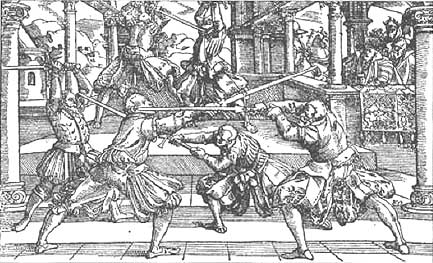 While the basis of all fighting arts can be reduced down to
the same essential principles as found in unarmed combat (leverage, timing,
range, etc.), and the source masters even tell us all fencing is based on
wrestling, it has always been armed
combat that has historically taken precedence. Fencing is not simply "armed
wrestling." It is fencing.
While the basis of all fighting arts can be reduced down to
the same essential principles as found in unarmed combat (leverage, timing,
range, etc.), and the source masters even tell us all fencing is based on
wrestling, it has always been armed
combat that has historically taken precedence. Fencing is not simply "armed
wrestling." It is fencing.
Though their actions have a common basis, the techniques that
can be used in the context of a sword fight are not identical to those of
unarmed combat. This is surely why the historical source teachings make
such a distinction between close-in actions of seizing and disarming ("or
wrestling at the sword"), and grappling and ground fighting as a subset.
Something that cannot be overlooked here is that if a
fighter has trained in grappling and wrestling then takes up the longsword,
this does not mean at all that they will be able to suddenly apply their
unarmed training to effectively wield the weapon against a skilled swordsman.
You have to learn how to integrate the tool into what is possible in a fight.
Weapons take precedent. I have
seen this repeatedly over the years.
Many senior members in the ARMA can attest to the difficulty they had
when they started out trying to use even the most basic of their unarmed skills
against a well-trained swordsman.
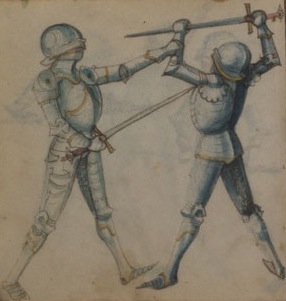 In
my own experience, because I never trained in any
wrestling or grappling, don't feel tactically comfortable there and
don't
consciously go to those techniques, I came (as a natural result) to
specialize more in my practice upon these earlier actions
occurring just before that range
(the disarms and trapping). But,
curiously, I acquired my unarmed close-in skills specifically through
training in the longsword. The longsword
taught me tremendously about feeling leverage and sensing pressure during any
portion or range of the fight, not just when blades are crossed. I learned to
apply my second hand and my whole body as needed even as I remained focused on
wielding my weapon. I didn't gain
any of this crucial aspect through any experience in rapier, sword &
dagger, or staff weapons.
In
my own experience, because I never trained in any
wrestling or grappling, don't feel tactically comfortable there and
don't
consciously go to those techniques, I came (as a natural result) to
specialize more in my practice upon these earlier actions
occurring just before that range
(the disarms and trapping). But,
curiously, I acquired my unarmed close-in skills specifically through
training in the longsword. The longsword
taught me tremendously about feeling leverage and sensing pressure during any
portion or range of the fight, not just when blades are crossed. I learned to
apply my second hand and my whole body as needed even as I remained focused on
wielding my weapon. I didn't gain
any of this crucial aspect through any experience in rapier, sword &
dagger, or staff weapons.
I
have no doubts that learning unarmed skills did not give me
corresponding knowledge of fighting with a weapon. In other words,
while I had previously learned how to kick and punch, and so was
comfortable fighting at close ranges, it was however through studying
the longsword that I was able to incorporate such actions when wielding
a weapon. [It must be further noted, that, at such close ranges, modern
fencing styles not only fail to instruct in basic defense against body
contact and free-hand actions, but under those conditions also coaches
to habitually perform suicidal techniques.]
Making the Longsword Central Again
Historically, schools and masters of fence from the Middle
Ages to the Renaissance did teach a variety of weapons together with
wrestling/grappling skills. Yet,
for some time they focused on the longsword (or sometimes the polaxe for
armored single-combat, and later the rapier instead of the longsword for
unarmored duel). They had to do this because their lives depended on competent
ability. Ours now do not. In our modern study we have to therefore engineer a
certain restructuring of the craft for modern practice (without reformulating a new systemization in the process!).
If you train
long-term in the longsword vigorously you will also come to an understanding of
unarmed throws and holds. The same clear connection cannot be said nearly as
much for training in unarmed skills alone. From
my experience studying and teaching this craft, I am
fully convinced that if you practice the longsword I guarantee you
learn some
wrestling moves and unarmed striking---but the reverse is not true. If
you
learn the longsword you can instantly adapt it to the single-hand sword
alone
(from which all double-hand techniques originate) as well as apply it
to using a buckler or even a larger shield. If you train in longsword
you learn elements instantly transferable
to the dagger or to the staff. But for the reverse, not nearly as much
transfers from any of those weapons alone over to techniques applicable
for
striking strongly and warding carefully with the longsword.
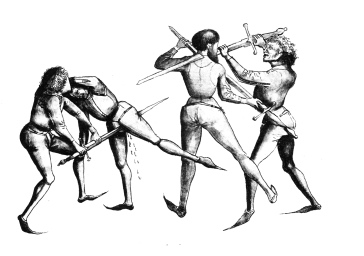 It is perhaps the lost
of central training in the importance of longsword that helps explain
why the
martial arts of the Renaissance faded and vanished. I suggest the very
reason
that this Art of Fighting was not already reconstructed by enthusiasts
over the last century is not because of any lack of source
material for its study,
but because of the overall loss of longsword training within modern
fencing culture itself.
It is perhaps the lost
of central training in the importance of longsword that helps explain
why the
martial arts of the Renaissance faded and vanished. I suggest the very
reason
that this Art of Fighting was not already reconstructed by enthusiasts
over the last century is not because of any lack of source
material for its study,
but because of the overall loss of longsword training within modern
fencing culture itself.
It cannot be overstated how profound a missing skill set
there is within modern fencing styles with their total lack of any
double-handed weapon, let alone any grappling component or use of the
second-hand. The disconnect between these styles and the old systems of
knightly combat was too great to be bridged through a mere similarity with the
rapier of centuries past. They were (and still are) simply unable to rely on their methods to
rediscover the forgotten Art.
It requires practice of the
longsword.
You cannot fully understand or
reconstruct this style of fencing via training in epee or saber or knife or
quarterstaff or cane. You
certainly can't understand it just by mixing wrestling and boxing with foil
fencing. None of these things provide what the longsword does in terms of a
well-rounded understanding of the core elements of close combat as a true
martial art.
|
Focus on Fencing with the Longsword
No one questions the value for the student today of practice
in multiple weapons or of the eventual specialization in a preferred weapon or
skill set. Nor is the uniqueness and deadliness of the rapier in doubt,
either. Yet, I am quite confident
it can now been established that the larger Art of historical European combatives we explore is best (and
most easily) unlocked through dedicated
training in the longsword.
Though we would not suspect it from the simplistic way the
weapon is typically mis-portrayed in popular culture, the inferior way it is
notoriously handled by stunt fencers and many other enthusiasts, the longsword
is undeniably versatile and sophisticated. Within its middle size length with
symmetrical grip it contains a larger pool of core elements integral to the
discipline of close combat skill. This is surely why it was so emphasized
historically by Masters of Defence.
Within the study of this craft we
can with confidence make certain educated generalizations about the value of
particular skills. There is no doubt of the element of grappling and wrestling
within Renaissance martial arts being integral to all weapons, and there is no
questioning the common necessity of dagger skill, nor the utility of the simple
staff as the fundamental polearm. The ability to wield a single-hand sword
alone or in conjunction with another weapon was also fundamental. But for
generations the longsword provided the central basis of study. Only when the
innovation of the rapier emerged later in a transformed self-defense
environment did this change.
For too long the true handling of this powerful tool has
gone under-appreciated and misrepresented.
As we approach a full understanding of the longsword and the Renaissance Art
of Defence, we can now better appreciate
centrality the weapon held and focus on it once again. Just as its emergence in the 14th century arguably
caused a "renaissance" in close-combat skills beyond what was being
done with spear,
axe, and short-sword and shield (buckler), so too has the longsword
today over
any other weapon spurred similar insight.
Thus, while our interest in this craft today may range from 14th
and 15th century knightly combat skills to the private fighting
methods of 16th century cavaliers, they all represent linked aspects
of the martial arts of Renaissance Europe---an Art unlocked by the longswordThe longsword is arguably the central weapon for studying RMA --- the key word here being central weapon of study.
Both Master Liechtenauer and Master Fiore do tell us unarmed skills are
the origin of fighting, yes. No one denies that. Yet, master
Liechtenauer himself states that there is only one Art of the sword and
that it is the basis of all the arts of fighting --- the longsword, not
the dagger, not the staff, not the messer, not the later rapier, and
not unarmed fighting. Other sources declare the messer to be the origin
of all swordplay --- meaning that its moves are simply the same as any
short sword (which obviously predates the double-hand sword).
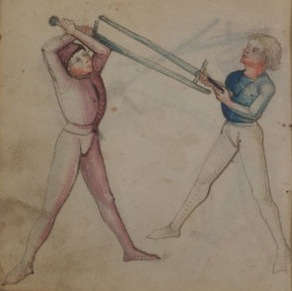 But, the sword was the self-defense weapon of choice in the era and its
utility and popularity was precisely why so much source material is
devoted to it over anything else. What the unarmed component is about
as a natural foundation of martial arts is that when you reduce
fighting to its most essential essence, it is about two combatants
closing to make contact and seek leverage advantage in order to deliver
techniques. You cannot be ignorant of unarmed techniques or exclude
them out of fencing. That's all it means. But you don't learn fencing by grappling and wrestling. The clearest
confirmation that unarmed skills do not teach fencing techniques is the
self-evident fact that today expert grapplers and wrestlers by virtue
of their craft do not inherently know how to fight with weapons. A
simple of understanding of balance and leverage is achieved in
learning a small repertoire of unarmed holds, throws, and takedowns all
of which are used in fencing. When lethal weapons are involved,
however, the
martial application of such action is far from the ad hoc sporting play
of wrestling. But, the sword was the self-defense weapon of choice in the era and its
utility and popularity was precisely why so much source material is
devoted to it over anything else. What the unarmed component is about
as a natural foundation of martial arts is that when you reduce
fighting to its most essential essence, it is about two combatants
closing to make contact and seek leverage advantage in order to deliver
techniques. You cannot be ignorant of unarmed techniques or exclude
them out of fencing. That's all it means. But you don't learn fencing by grappling and wrestling. The clearest
confirmation that unarmed skills do not teach fencing techniques is the
self-evident fact that today expert grapplers and wrestlers by virtue
of their craft do not inherently know how to fight with weapons. A
simple of understanding of balance and leverage is achieved in
learning a small repertoire of unarmed holds, throws, and takedowns all
of which are used in fencing. When lethal weapons are involved,
however, the
martial application of such action is far from the ad hoc sporting play
of wrestling.
But learn to fence properly with the longsword or short-sword and
buckler and you will indeed learn about unarmed actions. Learn only
gentlemanly dueling ala the Baroque style, however, and you will end up
as the Victorians did: viewing Renaissance fighting systems as
"artless" collections of techniques using "wrestling tricks" while
lacking the "parry proper."
|
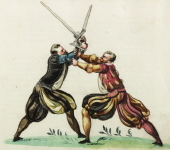
The longsword is arguably the central weapon for studying RMA --- the key word here being central weapon of study.
Both Master Liechtenauer and Master Fiore do tell us unarmed skills are
the origin of fighting, yes. No one denies that. Yet, master
Liechtenauer himself states that there is only one Art of the sword and
that it is the basis of all the arts of fighting --- the longsword, not
the dagger, not the staff, not the messer, not the later rapier, and
not unarmed fighting. Other sources declare the messer to be the origin
of all swordplay --- meaning that its moves are simply the same as any
short sword (which obviously predates the double-hand sword).
But,
the sword was the self-defense weapon of choice in the era and its
utility and popularity was precisely why so much source material is
devoted to it over anything else. What the unarmed component is about
as a natural foundation of martial arts is that when you reduce
fighting to its most essential essence, it is about two combatants
closing to make contact and seek leverage advantage in order to deliver
techniques. You cannot be ignorant of unarmed techniques or exclude
them out of fencing. That's all it means.
But you don't learn
fencing by grappling and wrestling. The clearest confirmation that
unarmed skills do not teach fencing techniques is the self-evident fact
that today expert grapplers and wrestlers by virtue of their craft do
not inherently know how to fight with weapons. A simple of
understanding of balance and leverage is achieved in
learning a small repertoire of unarmed holds, throws, and takedowns all
of which are used in fencing. When lethal weapons are involved,
however, the
martial application of such action is far from the ad hoc sporting play
of wrestling.
It was surely the immediacy of the lethality produced by weapons that
was the starkest reminder for the historical fighting man of which
skill set necessarily took precedent for self-defense. Whereas a
single blow of a weapon might very expectedly shear flesh, cleave the
skull, pierces the torso or face, and otherwise dismember, this is not
the case with an unarmed punch, kick, or throw. In contrast to the
grapples and holds of a friendly wrestling match, the instantaneous
nature of violent death in ones’ hands causes the Art of fencing to
produce a different mindset in the combatant, even during mock
combat. It is this fact that today’s student of Renaissance
martial arts, safely exploring techniques through practice bouts and
drills, should remain ever conscious of. |

